Typical values at TA = +25°C, ADC
Sampling Rate = 2949.12 GHz. Default conditions: output sample rate
= 491.52 MSPS (decimate by 6), PLL clock mode with fREF =
491.52 MHz, AIN = –3 dBFS, DSA setting = 4 dB.
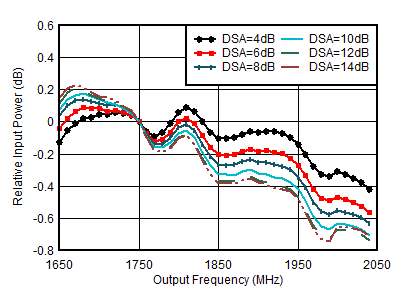
| With 1.8 GHz matching, normalized to 1.75 GHz |
|

| With 1.8 GHz matching, normalized to
phase at 25°C |
|
Figure 6-83 RX
Input Phase vs Temperature and DSA at fIN
= 1.75 GHz
| With 1.8 GHz matching |
| Differential Amplitude Error =
PIN (DSA Setting – 1) – PIN
(DSA Setting) + 1 |
Figure 6-85 RX
Calibrated Differential Amplitude Error vs DSA
Setting at 1.75 GHz
| With 1.8 GHz matching |
| Integrated Amplitude Error =
PIN (DSA Setting) – PIN (DSA
Setting = 0) + (DSA Setting) |
Figure 6-87 RX
Calibrated Integrated Amplitude Error vs DSA Setting
at 1.75 GHz
| With 1.8 GHz matching |
| Differential Phase Error =
PhaseIN (DSA Setting – 1) –
PhaseIN (DSA Setting) |
Figure 6-89 RX
Calibrated Differential Phase Error vs DSA Setting
at 1.75 GHz
| With 1.8 GHz matching |
| Integrated Phase Error = Phase (DSA
Setting) – Phase (DSA Setting = 0) |
Figure 6-91 RX
Calibrated Integrated Phase Error vs DSA Setting at
1.75 GHz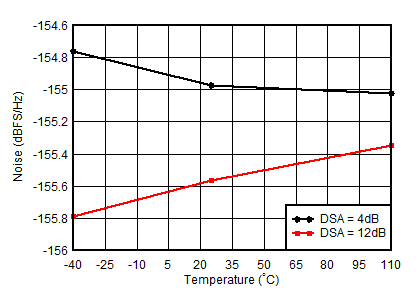
| With 1.8 GHz matching, 12.5-MHz offset from tone |

| With 1.8 GHz matching, 12.5-MHz offset
from tone |
|
Figure 6-95 RX
Noise Spectral Density vs Input Amplitude and
Channel at 1.75 GHz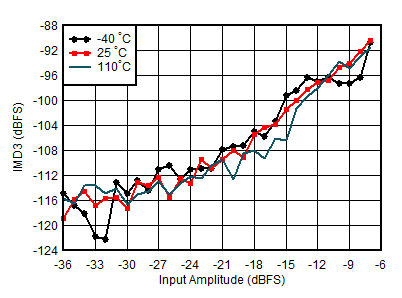
| With 1.8 GHz matching, tone spacing = 20 MHz, DSA = 4 dB |

| With 1.8 GHz matching, fin =
1900MHz, measured after HD2 trim, DDC bypass mode
(TI only mode for characterization) |
Figure 6-99 RX
HD2 vs DSA Setting and Channel at 1.9 GHz
| With 1.8 GHz matching, fin =
1900 MHz, measured after HD2 trim, DDC bypass mode
(TI only mode for characterization) |
Figure 6-101 RX
HD2 vs Input Amplitude and Channel at 1.9
GHz
| With 1.8 GHz matching, fin =
1900 MHz, DDC bypass mode (TI only mode for
characterization) |
Figure 6-103 RX
HD3 vs DSA Setting and Channel at 1.9 GHz
| With 1.8 GHz matching, fin =
1900MHz, DDC bypass mode (TI only mode for
characterization) |
Figure 6-105 RX
HD3 vs Input Level and Channel at 1.9 GHz
| With 1.8 GHz matching, decimated by
3 |
Figure 6-107 RX
In-Band SFDR (±400 MHz) vs Input Amplitude at 1.75
GHz
| With 1.8 GHz matching, –7 dBFS each
tone, 20-MHz tone spacing, all supplies at MIN,
TYP, or MAX recommended operating voltages |
Figure 6-109 RX
IMD3 vs Supply and Channel at 1.75 GHz
| With 1.8 GHz matching, normalized to
fullscale at 25°C for each channel |
Figure 6-82 RX
Input Fullscale vs Temperature and Channel at 1.75
GHz
| With 1.8 GHz matching |
| Differential Amplitude Error =
PIN (DSA Setting – 1) – PIN
(DSA Setting) + 1 |
Figure 6-84 RX
Uncalibrated Differential Amplitude Error vs DSA
Setting at 1.75 GHz
| With 1.8 GHz matching |
| Integrated Amplitude Error =
PIN (DSA Setting) – PIN (DSA
Setting = 0) + (DSA Setting) |
Figure 6-86 RX
Uncalibrated Integrated Amplitude Error vs DSA
Setting at 1.75 GHz
| With 1.8 GHz matching |
| Differential Phase Error =
PhaseIN (DSA Setting – 1) –
PhaseIN (DSA Setting) |
Figure 6-88 RX
Uncalibrated Differential Phase Error vs DSA Setting
at 1.75 GHz
| With 1.8 GHz matching |
| Integrated Phase Error = Phase(DSA
Setting) – Phase(DSA Setting = 0) |
Figure 6-90 RX
Uncalibrated Integrated Phase Error vs DSA Setting
at 1.75 GHz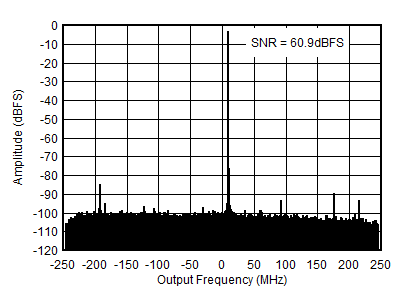
| With 1.8 GHz matching, fIN = 2610 MHz, AIN= –3 dBFS |
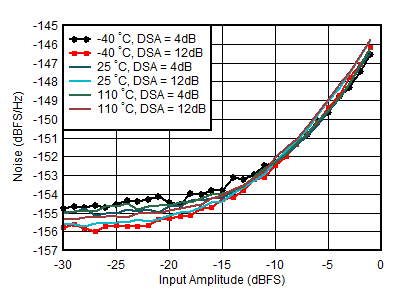
| With 1.8 GHz matching, DSA Setting = 12 dB, 12.5-MHz offset from tone |
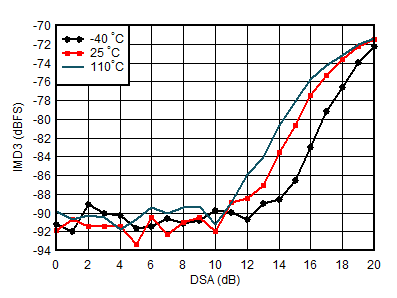
| With 1.8 GHz matching, each tone –7 dBFS, tone spacing = 20 MHz |
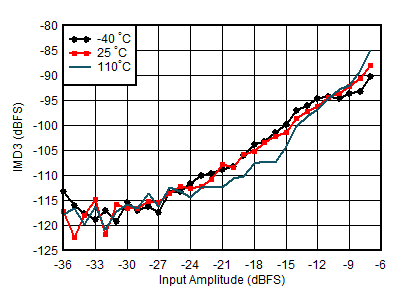
| With 1.8 GHz matching, tone spacing = 20 MHz, DSA = 12 dB |
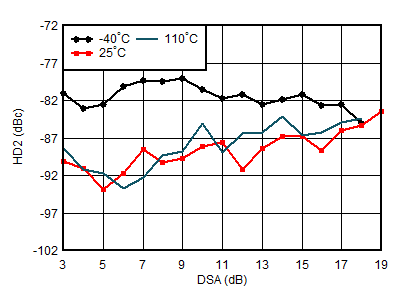
| With 1.8 GHz matching, fin = 1900
MHz, measured after HD2 trim, DDC bypass mode (TI
only mode for characterization) |
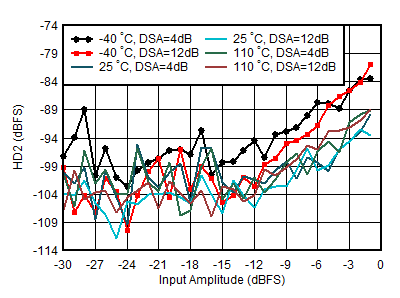
| With 1.8 GHz matching, fin = 1900
MHz, measured after HD2 trim, DDC bypass mode (TI
only mode for characterization) |

| With 1.8 GHz matching, fin =
1900 MHz, DDC bypass mode (TI only mode for
characterization) |
Figure 6-104 RX
HD3 vs DSA Setting and Temperature at 1.9
GHz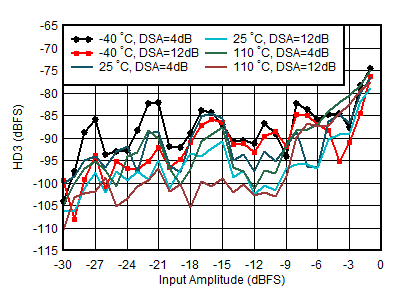
| With 1.8 GHz matching, fin = 1900
MHz, DDC bypass mode (TI only mode for
characterization) |
 Figure 6-108 RX
Non-HD2/3 vs DSA Setting at 1.75 GHz
Figure 6-108 RX
Non-HD2/3 vs DSA Setting at 1.75 GHz
| With 1.8 GHz matching, 12.5-MHz offset,
all supplies at MIN, TYP, or MAX recommended
operating voltages |
Figure 6-110 RX
Noise Spectral Density vs Supply and Channel at 1.75
GHz




























